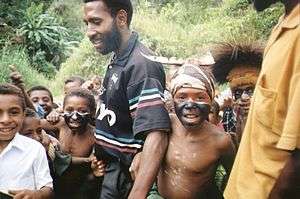Papuan people
| Orang Papua | |
|---|---|
 Children dressed up for sing-sing | |
| Regions with significant populations | |
|
| |
| 2,693,630[1] | |
| 6,000 | |
| 1,500 | |
| 2,000 | |
| 1,000 | |
| 500 | |
| Languages | |
| Religion | |
| Related ethnic groups | |
Papuan people are the indigenous peoples of New Guinea and neighbouring islands, speakers of the Papuan languages. They are distinguished ethnically and linguistically from the Austronesians of Melanesia, speakers of Austronesian languages introduced into New Guinea and nearby islands about 3,000 years ago.
Genetics
In a 2005 study of ASPM gene variants, Mekel-Bobrov et al. found that the Papuan people have among the highest rate of the newly evolved ASPM haplogroup D, at 59.4% occurrence of the approximately 6,000-year-old allele.[2] While it is not yet known exactly what selective advantage is provided by this gene variant, the haplogroup D allele is thought to be positively selected in populations and to confer some substantial advantage that has caused its frequency to rapidly increase.
Main Y-DNA haplogroups of Papuan people are haplogroup K2b1 (Y-DNA) and Haplogroup C1b2a.[3]
Papuan ethnic groups
Australia
East Timor
- Bunak
- Fataluku
- Makasae
Indonesia
Papua New Guinea
 Girls from Papua New Guinea
Girls from Papua New Guinea Papuan people in folk costume in Jakarta
Papuan people in folk costume in Jakarta
Notable people
- Abba Bina, notable businessman
- Frans Kaisiepo, 4th Governor of Papua and National Hero of Indonesia
- Nitya Krishinda Maheswari, Indonesian badminton player and 2014 Asian Games women's doubles gold medalist
- Peter O'Neill, 7th Prime Minister of Papua New Guinea
- Freddy Numberi, politician and former Indonesian minister
- Raema Lisa Rumbewas, Indonesian weightlifter and silver medalist at 2000 Summer Olympics and 2004 Summer Olympics
- Boaz Solossa, Indonesian professional footballer
- Michael Somare, former Prime Minister of Papua New Guinea
- Heather Watson, English female tennis player
See also
References
- ↑ "Kewarganegaraan, Suku Bangsa, Agama, Dan Bahasa Sehari-Hari Penduduk Indonesia". Badan Pusat Statistik. 2010. Retrieved 18 July 2017.
- ↑ "Ongoing Adaptive Evolution of ASPM, a Brain Size Determinant in Homo sapiens", Science, 9 September 2005: Vol. 309. no. 5741, pp. 1720–1722.
- ↑ 崎谷満『DNA・考古・言語の学際研究が示す新・日本列島史』(勉誠出版 2009年)(in Japanese)
Further reading
- W. G. Lawes (1882), "New Guinea and Its People", Popular Science Monthly
External links
